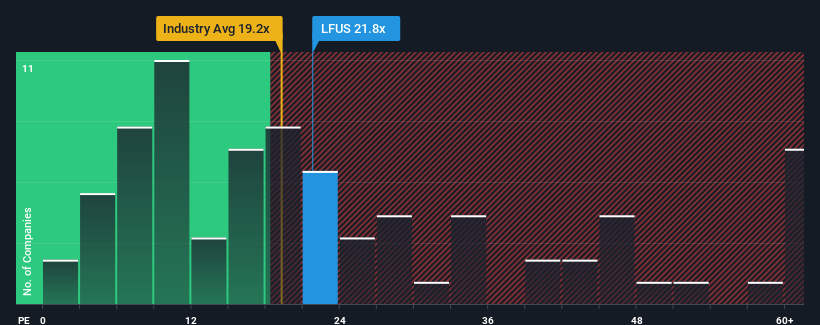- United States
- /
- Electronic Equipment and Components
- /
- NasdaqGS:LFUS
Littelfuse, Inc.'s (NASDAQ:LFUS) Share Price Could Signal Some Risk

With a price-to-earnings (or "P/E") ratio of 21.8x Littelfuse, Inc. (NASDAQ:LFUS) may be sending bearish signals at the moment, given that almost half of all companies in the United States have P/E ratios under 16x and even P/E's lower than 9x are not unusual. Nonetheless, we'd need to dig a little deeper to determine if there is a rational basis for the elevated P/E.
With earnings that are retreating more than the market's of late, Littelfuse has been very sluggish. It might be that many expect the dismal earnings performance to recover substantially, which has kept the P/E from collapsing. You'd really hope so, otherwise you're paying a pretty hefty price for no particular reason.
View our latest analysis for Littelfuse

Does Growth Match The High P/E?
The only time you'd be truly comfortable seeing a P/E as high as Littelfuse's is when the company's growth is on track to outshine the market.
Retrospectively, the last year delivered a frustrating 31% decrease to the company's bottom line. Still, the latest three year period has seen an excellent 95% overall rise in EPS, in spite of its unsatisfying short-term performance. Accordingly, while they would have preferred to keep the run going, shareholders would probably welcome the medium-term rates of earnings growth.
Looking ahead now, EPS is anticipated to climb by 10% per annum during the coming three years according to the eight analysts following the company. With the market predicted to deliver 11% growth per year, the company is positioned for a comparable earnings result.
In light of this, it's curious that Littelfuse's P/E sits above the majority of other companies. It seems most investors are ignoring the fairly average growth expectations and are willing to pay up for exposure to the stock. Although, additional gains will be difficult to achieve as this level of earnings growth is likely to weigh down the share price eventually.
The Final Word
It's argued the price-to-earnings ratio is an inferior measure of value within certain industries, but it can be a powerful business sentiment indicator.
Our examination of Littelfuse's analyst forecasts revealed that its market-matching earnings outlook isn't impacting its high P/E as much as we would have predicted. When we see an average earnings outlook with market-like growth, we suspect the share price is at risk of declining, sending the high P/E lower. This places shareholders' investments at risk and potential investors in danger of paying an unnecessary premium.
And what about other risks? Every company has them, and we've spotted 1 warning sign for Littelfuse you should know about.
Of course, you might find a fantastic investment by looking at a few good candidates. So take a peek at this free list of companies with a strong growth track record, trading on a low P/E.
New: AI Stock Screener & Alerts
Our new AI Stock Screener scans the market every day to uncover opportunities.
• Dividend Powerhouses (3%+ Yield)
• Undervalued Small Caps with Insider Buying
• High growth Tech and AI Companies
Or build your own from over 50 metrics.
Have feedback on this article? Concerned about the content? Get in touch with us directly. Alternatively, email editorial-team (at) simplywallst.com.
This article by Simply Wall St is general in nature. We provide commentary based on historical data and analyst forecasts only using an unbiased methodology and our articles are not intended to be financial advice. It does not constitute a recommendation to buy or sell any stock, and does not take account of your objectives, or your financial situation. We aim to bring you long-term focused analysis driven by fundamental data. Note that our analysis may not factor in the latest price-sensitive company announcements or qualitative material. Simply Wall St has no position in any stocks mentioned.
About NasdaqGS:LFUS
Littelfuse
Designs, manufactures, and sells electronic components, modules, and subassemblies in the Americas, Asia-Pacific, and Europe.
Flawless balance sheet average dividend payer.
Similar Companies
Market Insights
Community Narratives




